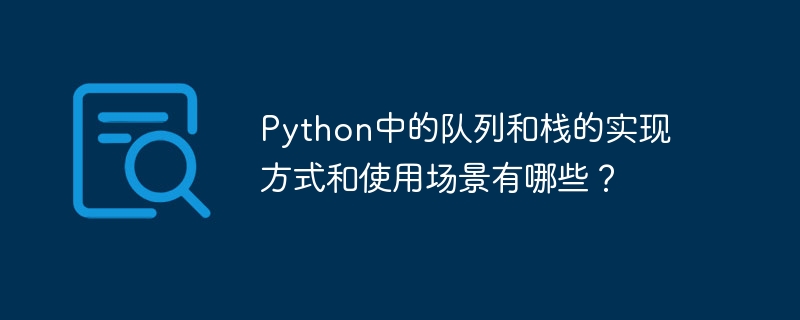Home >Backend Development >Python Tutorial >What are the implementation methods and usage scenarios of queues and stacks in Python?
What are the implementation methods and usage scenarios of queues and stacks in Python?
- 王林Original
- 2023-10-18 10:52:561453browse

What are the implementation methods and usage scenarios of queues and stacks in Python?
Queue and stack are two commonly used data types in data structures. They have different characteristics and usage scenarios respectively. Python provides a variety of implementation methods to create and operate queue (Queue) and stack (Stack) data structures.
- Queue implementation method:
1.1 Use list (List) to implement queue:
The characteristic of queue is usually "first in, first out". Lists in Python can be used to simply implement queue functions. Add elements to the end of the list using the append() method, and pop elements from the beginning of the list using the pop() method.
The sample code is as follows:
queue = [] # 入队操作 queue.append(1) queue.append(2) queue.append(3) # 出队操作 print(queue.pop(0)) # 输出 1 print(queue.pop(0)) # 输出 2
1.2 Use collections.deque to implement the queue:
Python’s collections module provides deque Class, which is an implementation of a double-ended queue. It features fast insert and pop operations, and can operate on elements from both ends of the queue.
The sample code is as follows:
from collections import deque queue = deque() # 入队操作 queue.append(1) queue.append(2) queue.append(3) # 出队操作 print(queue.popleft()) # 输出 1 print(queue.popleft()) # 输出 2
- How to implement the stack:
2.1 Use a list (List) to implement the stack:
Stack The characteristic is usually "last in first out", and using lists in Python can simply implement the function of the stack. Add elements to the end of the list using the append() method, and pop elements from the end of the list using the pop() method.
The sample code is as follows:
stack = [] # 入栈操作 stack.append(1) stack.append(2) stack.append(3) # 出栈操作 print(stack.pop()) # 输出 3 print(stack.pop()) # 输出 2
2.2 Use the LifoQueue class of the queue module to implement the stack:
Python's queue module provides LifoQueue class, which is the implementation of last-in-first-out queue (stack). You can use the put() method to put elements into the stack, and the get() method to pop elements from the stack.
The sample code is as follows:
from queue import LifoQueue stack = LifoQueue() # 入栈操作 stack.put(1) stack.put(2) stack.put(3) # 出栈操作 print(stack.get()) # 输出 3 print(stack.get()) # 输出 2
- Usage scenarios:
- Queue usage scenarios: Queues are suitable for scenarios that require first-in, first-out. For example, task scheduling, message delivery, etc. In multi-thread/multi-process programming, queues can be used to achieve secure communication between threads/processes.
- Stack usage scenarios: The stack is suitable for scenarios that require last-in-first-out, such as function call stacks, expression evaluation, undo operations, etc. Stacks can also be used to implement depth-first search algorithms (DFS) and backtracking algorithms.
To sum up, queues and stacks have simple and flexible implementations in Python. Which method to choose depends on the specific application scenarios and requirements. For queues, using lists or deque classes can meet basic needs; for stacks, using lists or LifoQueue classes can meet basic needs.
The above is the detailed content of What are the implementation methods and usage scenarios of queues and stacks in Python?. For more information, please follow other related articles on the PHP Chinese website!
Related articles
See more- 7 common usage scenarios of Redis (PHP practical)
- Detailed introduction of network card multi-queue technology and RSS function
- Win32 SDK Basics (11) Detailed explanation of message queue and GetMessage/PeekMessage, SendMessage/Postmesage
- How to understand what a stack is
- A brief analysis of Vue.set and this.$set in Vue and a look at the usage scenarios!

